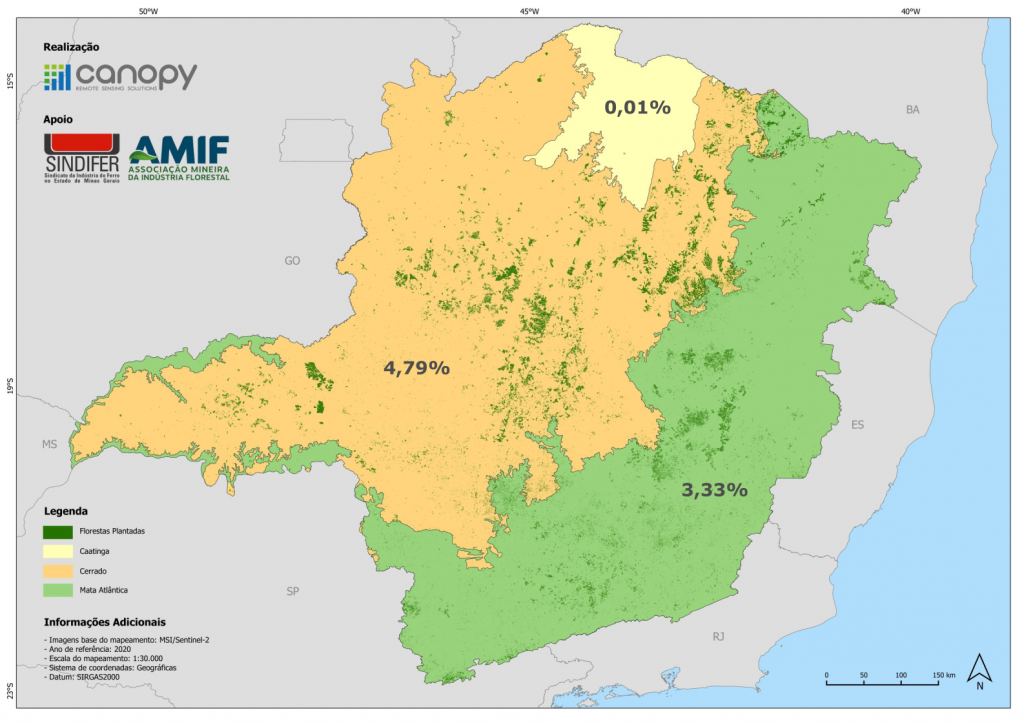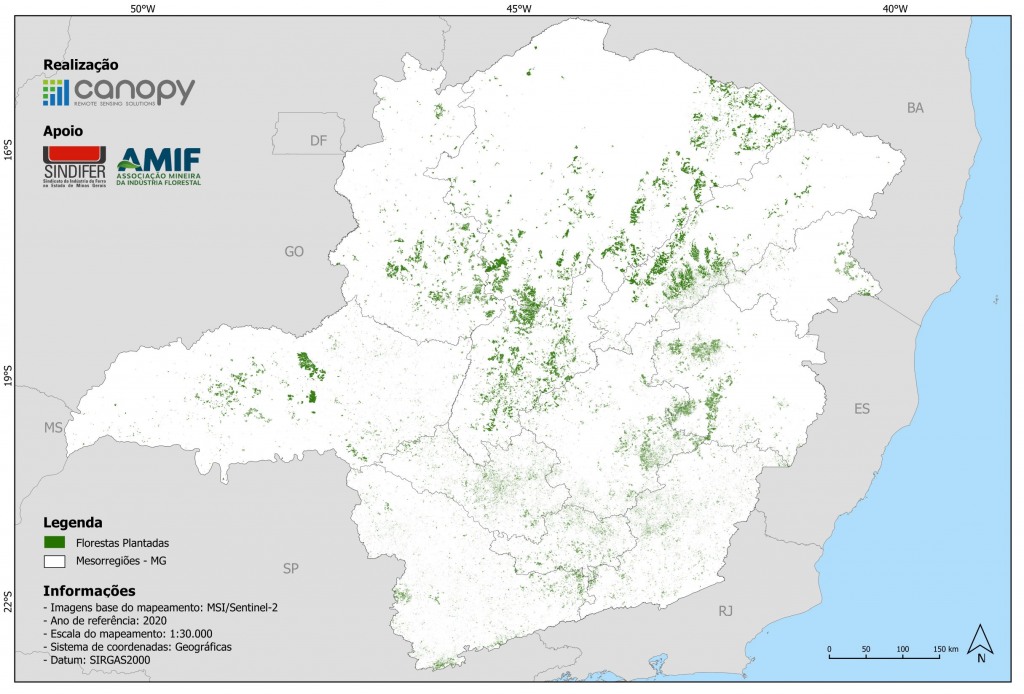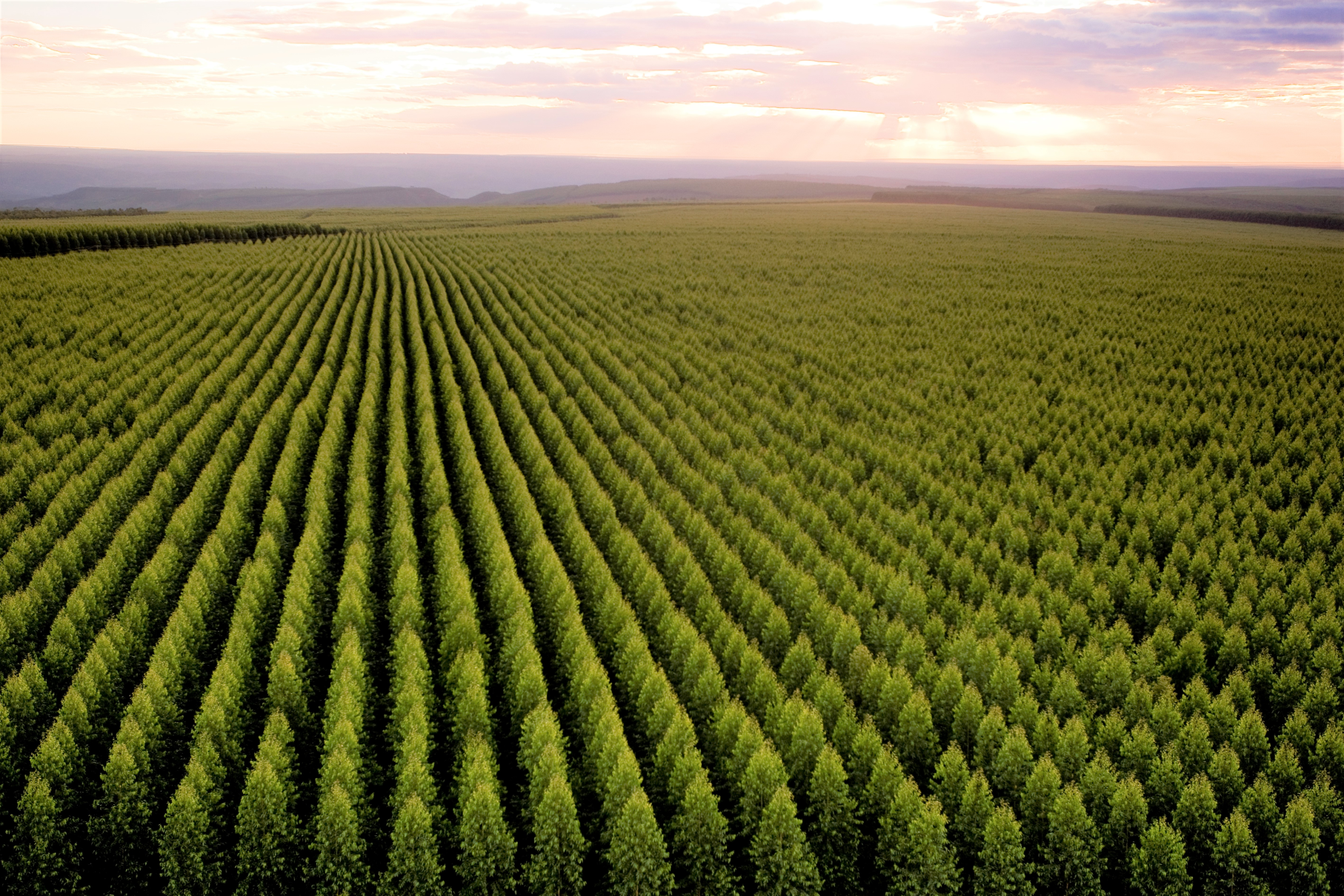Study confirms 2.3 million hectares of productive areas and additional 1.3 million of conserved native areas in all the regions of the state.
The largest survey ever to be carried out with satellite images in Minas Gerais was recently concluded with a precision higher 97% in the mapping and characterization of the planted forests in the state. The data consolidate the planted forests as the larger agricultural crops in Minas Gerais and that it can be found in 803 (94%) townships. This is the most detailed study ever carried out by the sector: there are 2.3 million hectares of production forests and additional 1.3 million hectares of conserved native forests in 2020. For each hectare of cultivated forest, 0.6 hectare of native forest is preserved, either as a Permanent Preservation Area (PPA), Legal Reserve (LR) or Private Reserve of Natural Heritage (PRNH).
The images allowed obtaining data from cultivated areas with 0.25 hectare. Another novelty is that the survey points out the classes of land use and cover that have replaced or been replaced by cultivated forests, in addition to the cultivated species. The survey was carried out by the startup with the support of Union of the Iron Industry in the State of Minas Gerais (SINDIFER) and the Association of the Forest Industry in Minas Gerais (AMIF). “We have made kind of cross between the most innovative technologies of satellite images and the evaluation of human eye. Thus, it was possible to have a reliable portrait of the planted forests in Minas Gerais,” highlights Adriana Maugeri, AMIF president.
The survey is strategic for decision-making in the agro-industry and for the development of the sector The National Plano of Planted Forests established as a goal to enlarge the production area in 2 million hectares until 2020 (roughly 20%). The mission that we have embraced at Canopy is to use the state of the art in geotechnologies to deliver not only a complete x-ray of the cultivated forest areas in Minas and Brazil, but a system to support forestry decision, with systematic, accurate and updated information”, states Fábio Gonçalves, co-founder a CEO of Canopy Remote Sensing Solutions.
Panels, laminated floor, lumber, treated wood, charcoal, pulp and paper are some of the products obtained from de planted forests. Such products also strengthen the state's position internationally: Minas Gerais remains as a world leader in production and consumption of charcoal. “Charcoal is an important input also in the production of pig iron by the steel mills in Minas Gerais. In addition to the cultivated area, it is fundamental to know what available wood we have in our state. With this technology, very soon, we will have the volume of available wood in the planted areas, i. e., a relevant information for the mills in their planning, states Fausto Varela, SINDIFER president.
The survey utilized more than 3,500 satellite images collected over Minas Gerais territory in the last decade. Eucalyptus genus is the main cultivation among the forest plantations, occupying 96.8% of total acreage. Northern Minas Gerais concentrates 25% of the forest base in the state, followed by Jequitinhonha Valley (13%) and Central Region (12%). The other regions represent the other half the total amount of cultivated area.
Expansion of the Forest Base
The expansion of the forest base occurred in about 29.2 thousand hectares, compared to the period of 2018/2019. The new plantations are in the North Region (38%), Central Region (28%) and Jequitinhonha Valley (16%). On the other hand, some 9.5 hectares of forest plantations were converted to other agricultural crops (39%), pastures (11%) and other land uses (50%), such as allotment and mining areas. Considering the expansion and retraction areas, the survey indicates a positive balance of 19.7 thousand hectares, roughly equivalent to a growth of 1% in planted forests in relation to 2018/2019.
Acreage per biome
Minas Gerais territory is covered by three biomes in its full extension, in accordance with classification of Brazilian Institute of Geography and Statistics (IBGE). They are: Cerrado (54%), Atlantic Forest (40%) and Caatinga (6%). Planted forests in Minas Gerais can be found in 4.79% of Cerrado area, 3.33 of Atlantic Forest area and 0.01% in Caatinga area.
Land use within each biome in Minas Gerais
| Biome | Planted Forest (%) | Other uses (%) |
| Atlantic Forest | 3,33 | 96,67 |
| Cerrado | 4,79 | 95,21 |
| Caatinga | 0,01 | 99,99 |

Planted Forests in Minas Gerais
The data resulting from the new survey confirms Minas Gerais position as the largest producer of cultivated forests in Brazil. Although planted forests represent (roughly) only 1% of Brazilian territory, about 90% of the wood produced for industrial purposes come from these forests. This is what says Brazilian Institute of Trees (IBÁ).
Planted forests reduce the pressure on native forests because they supply all the inputs needed in the wood productive chain. They also contribute to keeping the water in the soil, capture carbon and release oxygen to the atmosphere reducing impacts of greenhouse gases. The cultivation of these forests is based on sustainable land use practices that are confirmed by national and international certifications.
“We have shown that it is entirely possible to promote economic development combined with environmental conservation and respect for the communities that integrate the territories where we operate. For the cultivated forest to survive and produce satisfactorily, it is essential to conserve natural resources. Wood is one of the noblest and most consumed materials in human history. The current concern that must guide society is to demand the sustainable and legal origin of this wood. This is the role of the forest industry: to offer the market a wood that fully presents all the care and concern for the sustainability of our planet”, explains Adriana Maugeri, AMIF president.

AMIF and SINDIFER
Association of the Forest Industry in Minas Gerais (AMIF) represents the planted forests producers with the purpose of sustainably harvesting wood. AMIF also represents consumers of forest products and by-products. By its turn, the Union of the Iron Industry in the State of Minas Gerais (SINDIFER) has a close relation with planted forests due to the use of charcoal (from these forests) in the production of pig iron.

Original text and images: Communication office - AMIF The translation into English was done by Dárcio Calais, technical assistant at SINDIFER

